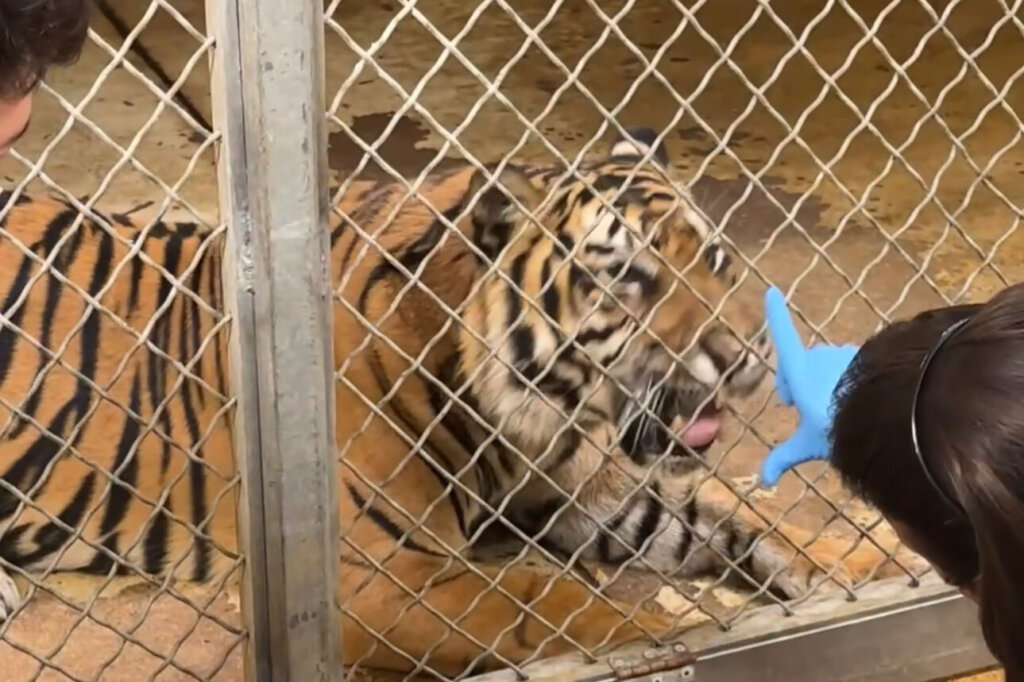
WTOP’s Matt Kaufax talks with animal keeper Charlie Shaw, who cares for big cats at the National Zoo, about the vital conservation efforts underway to protect endangered tiger species.
In the D.C. region, conversations often start with, “What do you do?” WTOP’s series “Working Capital” profiles the people doing the work that makes the region unique.
This page contains a video which is being blocked by your ad blocker.
In order to view the video you must disable your ad blocker.
Day in the life of a Great Cats animal keeper at the Smithsonian’s National Zoo!
Imagine being face-to-face with 300-plus pound apex predators every day of your life.
“I do forget how unique it is sometimes,” said Charlie Shaw, animal keeper of Big Cats at the Smithsonian’s National Zoo and Conservation Biology Institute. “I go home and people are like, ‘What’d you do today?’ Oh, I just fed a tiger. They’re like ‘you fed a tiger!’ People don’t do that!”
Shaw said ever since he got to the zoo over five years ago, working with the majestic creatures in the zoo’s Great Cats wing has been a dream.
“They give you a tour of the zoo when you first get here, and a guy goes, ‘What’s your 5-year plan?’ Shaw told WTOP. “And I said, I think I want to work with big cats. Then, a year in, they’re like, ‘we’re transferring you,’ and I was like, ‘Well, no more 5-year plan. I guess I’m already there!’”
The first thing you see when you walk inside the Great Cats wing are multiple massive lions slumbering — which is enough to wake anyone up early in the morning.
A typical day in his life starts with food, which can be a pretty big motivation for all the cats here, particularly 16-year-old tiger Damai. The Sumatran tiger paces eagerly waiting for raw beef chunks to be deposited into her cage.
“She’s like, ‘Where are the snacks?’” Shaw joked.
Between the lions and tigers, like 3-year-old Vostok, of the very large Amur (also known as Siberian) species, thousands of grams of raw protein are devoured every day.
The second activity of the day involves “enrichment,” which involves setting up toys in the enclosures to engage the cats and provide entertainment to stimulate their minds.
There’s a wide variety to choose from: a giant whiffle ball-like toy with a smaller ball in the middle, and even giant beer kegs that Shaw said some of the lions use like a barrel-roll treadmill.
Part of enrichment also includes sprinkling spices into the cats’ cages. Shaw said cats communicate through scents and their affinity for certain smells is almost like wearing a signature cologne.
On the particular day WTOP shadowed Shaw, he sprinkled some fennel into Damai’s cage. Minutes later when she entered, she rolled around on the floor where the spice was sprinkled to cover herself in the scent.
“My favorite is training with these guys,” Shaw said, referring to the coolest part of the job.
Training is the crux of what makes the relationship between keeper and big cat thrive. They’ve got it down to a science at the zoo, so Shaw is able do things like tell the tigers to open their mouths, so he can examine them to see if they need dental care.
But, he warned, you must tread lightly.
“It is remembering that they still are very dangerous wild animals, which is why we have all that safety stuff,” he said.
A big part of Shaw’s job is making sure gates are locked, doors are barred and all precautions are followed to coexist peacefully.
“They look so friendly. Especially Vostok, he has such a sweet face,” Shaw said. “And you’re like ‘just one hug!’ No. There would be one hug, but that would be it forever!”
The last component of a great cat keeper’s job, conservation, is arguably the most important.
The zoo just got a new tiger that hasn’t been introduced to the public yet. Her name is Coba, and she’s set to be paired with Vostok in an aim to help repopulate the species.
“Tigers are critically endangered,” Shaw said. “What we want to do is make sure the gene pool itself is still very diverse.”
In an ideal world, Shaw said, he wouldn’t be giving this interview, and the great cats wouldn’t be here — they’d be safe to roam free.
“But if (the zoo has) to do it, at least people can come and go, ‘Oh, my God, that tiger. So cool! How can I help tigers at home?’”
Next time you visit the National Zoo, Shaw recommended asking a zookeeper about how you can help these majestic creatures each and every day. They offer windows each day where the public can meet a Great Cats keeper and ask questions.
Your daily conservation contribution as a citizen could be as simple as buying less products that contain palm oil in your day-to-day life.
“One of the big things for tigers is habitat … and there are more sustainable ways to go about it,” Shaw said, adding: “Deforestation is the main factor in a lot of these big cats are losing their habitats.”
As the zoo crosses its fingers for a new tiger cub sometime in the not-too-distant future, Shaw said he’ll keep doing what he does best.
“You walk in and the tigers all chuff at you, or the lions roar. And you’re like, ‘Oh, my God, this is my job every day!’”
Hear “Matt About Town” first every Tuesday and Thursday on 103.5 FM!
If you have a story idea you’d like Matt to cover, email him, or chat with him on Instagram and TikTok.
Check out all “Matt About Town” episodes here!
Get breaking news and daily headlines delivered to your email inbox by signing up here.
© 2025 WTOP. All Rights Reserved. This website is not intended for users located within the European Economic Area.



